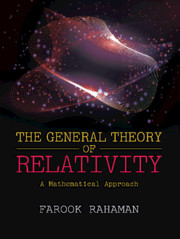Book contents
- Frontmatter
- Dedication
- Contents
- List of Figures
- List of Tables
- Preface
- Acknowledgments
- Chapter 1 Tensor Calculus — A Brief Overview
- Chapter 2 Geodesic
- Chapter 3 Einstein Field Equations
- Chapter 4 Linearized Gravity
- Chapter 5 Lie Derivatives and Killing’s Equation
- Chapter 6 Spacetimes of Spherically Symmetric Distribution of Matter and Black Holes
- Chapter 7 Particle and Photon Orbits in the Schwarzschild Spacetime
- Chapter 8 Causal Structure of Spacetime
- Chapter 9 Exact Solutions of Einstein Equations and Their Causal Structures
- Chapter 10 Rotating Black Holes
- Chapter 11 Elementary Cosmology
- Chapter 12 Elementary Astrophysics
- Appendix A Extrinsic Curvature or Second Fundamental Form
- Appendix B Lagrangian Formulation of General Relativity
- Appendix C 3+1 Decomposition
- Bibliography
- Index
Appendix C - 3+1 Decomposition
Published online by Cambridge University Press: 24 March 2021
- Frontmatter
- Dedication
- Contents
- List of Figures
- List of Tables
- Preface
- Acknowledgments
- Chapter 1 Tensor Calculus — A Brief Overview
- Chapter 2 Geodesic
- Chapter 3 Einstein Field Equations
- Chapter 4 Linearized Gravity
- Chapter 5 Lie Derivatives and Killing’s Equation
- Chapter 6 Spacetimes of Spherically Symmetric Distribution of Matter and Black Holes
- Chapter 7 Particle and Photon Orbits in the Schwarzschild Spacetime
- Chapter 8 Causal Structure of Spacetime
- Chapter 9 Exact Solutions of Einstein Equations and Their Causal Structures
- Chapter 10 Rotating Black Holes
- Chapter 11 Elementary Cosmology
- Chapter 12 Elementary Astrophysics
- Appendix A Extrinsic Curvature or Second Fundamental Form
- Appendix B Lagrangian Formulation of General Relativity
- Appendix C 3+1 Decomposition
- Bibliography
- Index
Summary
To describe the Hamiltonian formulation of a field theory in curved spacetime it is necessary to foliate W, a region in the spacetime, with a family of space-like hypersurfaces, Σ, in every “instant of time.” This is the purpose of the breakup of spacetime into space and time, i.e., 3+1 decomposition.
To express this decomposition one needs a scalar field t(xα) such that the surface of constant time (t = constant) represents a family of nonintersecting space-like hypersurfaces Σt.
Let nα α 𝜕αt, the unit normal to the hypersurfaces, be a future-directed time-like vector field. Now one can introduce new coordinates, ya in each hypersurface Σt. Let us assume a congruence of curves γ intersecting the hypersurfaces Σt (see Fig. 111).
[Let O be an open region in spacetime. A congruence in O is a family of curves such that through each point in O there passes one and only one curve from this family (the curves do not intersect)]
Let tα be the tangent to the congruence satisfying
Let a specific congruence curve γp pass through a point P on Σt and meet a point p′ on, and then a point p′′ on, etc. Now one can fix coordinates of p′ and P′′ by imposing
for a given ya(P) on Σt. Therefore, we can fix ya for every member of the congruence. Thus, in this way we can describe a new coordinate system (t, ya) in W.
Here spacetime is foliated in terms of space-like three-dimensional hypersurfaces Σt and the spacetime manifold W is diffeomorphic to R × Σt, where the manifold Σ t represents space and t ∈ R represents time. One can note that the particular slicing of spacetime into instants of time is fully arbitrary.
It is obvious that spacetime coordinate xμ must be some function of ya and t, i.e., xα = xα(t, ya).
Here,
Now, one can define the tangent vector on Σt as
Also Lie derivative of the tangent vector is zero, i.e.,
- Type
- Chapter
- Information
- The General Theory of RelativityA Mathematical Approach, pp. 391 - 394Publisher: Cambridge University PressPrint publication year: 2021



